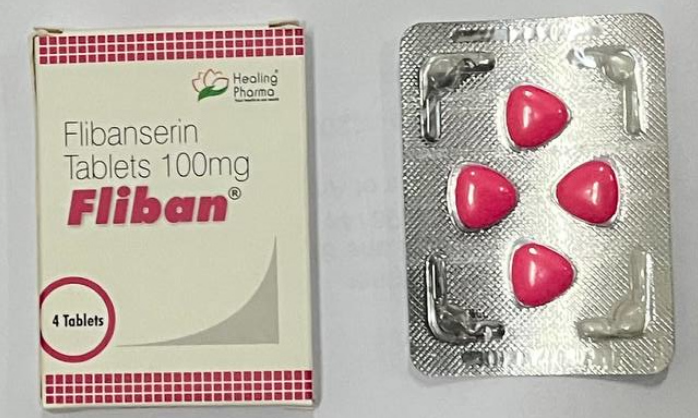Female Viagra
“Female Viagra” is not a single medication but rather a term used colloquially to refer to different medication approved for the treatment of pre-menopausal women with hypoactive sexual desire disorder. The medication improves sexual desire, increases the number of satisfying sexual events, and decreases the distress associated with low sexual desire.
The common medications that has been associated with the term “female Viagra” is flibanserin, marketed under the brand name Addyi. In United States, Flibanserin is approved by the U.S. Food and Drug Administration (FDA) for the treatment of hypoactive sexual desire disorder (HSDD) in premenopausal women and in Canada for premenopausal and postmenopausal women with HSDD.
HSDD is characterized by a persistent lack of sexual desire that causes distress or interpersonal difficulties. Flibanserin is not a hormonal therapy, but a medication to influence certain neurotransmitters in the brain.

Flibanserin is taken as an oral tablet once daily at bedtime. Unlike male Viagra, which is taken on an as-needed basis, flibanserin is intended for daily use to help improve sexual desire over time. It may take several weeks for women to notice any improvement in their sexual desire while taking this medication.
Common side effects include dizziness, nausea, fatigue, and sleepiness. Some women may also experience low blood pressure or fainting when taking flibanserin, especially if they consume alcohol or certain other medications concurrently.
The other medication associated with female sexual dysfunction treatment is bremelanotide, marketed as Vyleesi. Bremelanotide is an injectable medication that is used as needed and is designed to enhance sexual desire in women. Unlike flibanserin, which primarily addresses low sexual desire, bremelanotide focuses on increasing sexual arousal.
Male Viagra
‘Male Viagra,” more commonly known as Viagra, is a brand name for the medication sildenafil citrate. Viagra is used to enhance or maintain an erection sufficient for satisfactory sexual performance in men with erectile dysfunction. The other male Viagra is Tadalafil, sold under the brand name Cialis among others.
Viagra was the first oral medication approved by the U.S. Food and Drug Administration (FDA) for the treatment of ED. It received FDA approval in 1998 and has since become one of the most prescribed medications globally.
Viagra works by inhibiting an enzyme called phosphodiesterase type 5 (PDE5). This inhibition leads to increased blood flow to the penis, allowing men to achieve and sustain an erection when sexually stimulated. It does not, however, directly increase sexual desire.

Viagra is available in various dosages, ranging from 25 mg to 100 mg per tablet. The recommended starting dose is usually 50 mg, taken about 30 minutes to 1 hour before sexual activity. The effect of Viagra can last for up to 4-6 hours.
Viagra has been shown to be highly effective in enhancing and maintaining an erection, with a success rate of approximately 80-90%. However, its effectiveness may vary from person to person, depending on the underlying causes of ED and individual factors. It is important to stress that, this medication does not treat erectile dysfunction.
Common side effects of Viagra include headaches, facial flushing, indigestion, nasal congestion, and visual disturbances. These side effects are usually mild and temporary.
Viagra should not be taken with certain medications, particularly nitrates, which are often prescribed for chest pain (angina). It’s essential to inform your healthcare provider of all the medications you are taking and any underlying medical conditions, especially heart-related issues.
Male and Female Viagra: Key Differences
| Feature | Male Viagra (sildenafil or Tadalafil) | Female Viagra (Addyi or Vyleesi) |
|---|---|---|
| Purpose | Treats erectile dysfunction in men. | Used for the treatment of pre-menopausal women with hypoactive sexual desire disorder. |
| Mechanism of Action | Enhances blood flow to the penis, aiding in achieving and maintaining an erection. | The medication improves sexual desire, increases the number of satisfying sexual events, and decreases the distress associated with low sexual desire. |
| FDA Approval | Sildenafil and tadalafil are approved by the FDA for men with erectile dysfunction. There use is restricted to the supervision of a licensed health care professional. | The FDA has approved two drugs — flibanserin (Addyi) and bremelanotide (Vyleesi) — to address low desire or arousal in females. |
| Active Ingredients | Sildenafil citrate | Various active ingredients, such as flibanserin, bremelanotide, and others. |
| Mode of Administration | Oral tablet | Oral tablets, self-administered injections, or other forms |
| Targeted Issues | The main objective is achieving and sustaining an erection. | The objective is to address issues like low sexual desire (hypoactive sexual desire disorder), difficulty with sexual arousal, and pain during intercourse. |
| Hormonal Influence | Does not affect hormonal levels. | May have an affect on hormonal levels or receptors. |
| Potential Side Effects | Side effects may include headaches, flushing, and digestive issues. | Side effects may include dizziness, nausea and fatigue. |
| Usage in Menopausal Women | Can be taken by any man above 18 years. | Mainly used by menopausal and postmenopausal women who experience sexual dysfunction. |
| Recommended Use | Usually taken before sexual activity as needed. | May be taken daily or as needed. |
| Long-Term Effects | Primarily addresses immediate sexual function. | May have longer-term effects on sexual desire and arousal. |